A series of unsettling trends from soaring debt to falling spending suggest a U.S. stock market crash in 2015 looks increasingly likely.
Lately the six-year bull market has been looking tired. Despite a lot of volatility, stocks overall are flat on the year.
Meanwhile, the Dow Jones Industrial Average and the Standard & Poor's 500 are both within 3% of their all-time highs.
The question is whether the markets are taking a breather before moving on to new highs or whether they're just out of breath.
The big picture trends say this market is sucking wind.
For investors, the strong possibility of a U.S. stock market crash in 2015 calls for an adjustment in strategy. At minimum investors should choose stocks in "must-have" businesses instead of "nice-to-have" businesses. And they must remember to use trailing stops.
The problem equities are starting to have - and the reason a U.S. stock market crash may loom on the horizon - is that there's not enough money around to push stock prices higher.
Not so much the money to buy stocks. There always seems to be plenty of that. But value is driven by profits, which requires sales. And Americans don't have as much money to spend as they used to.
These charts illustrate what I'm talking about...
7 Charts Show the Case for U.S. Stock Market Crash 2015
U.S. Stock Market Crash 2015, Chart No. 1: People Are Holding on to Their Money
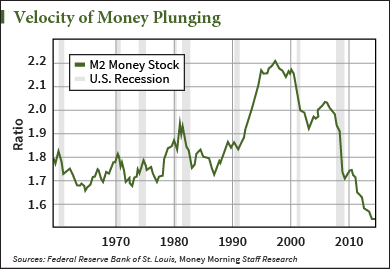 First, let's look at the velocity of money. That's simply how quickly money gets spent once acquired. Over the past two decades, the velocity of money has steadily declined.
First, let's look at the velocity of money. That's simply how quickly money gets spent once acquired. Over the past two decades, the velocity of money has steadily declined.
That tells us that people have become less and less willing to spend their money. This makes sense during a recession. People often get anxious they won't have enough money, so they're more reluctant to part with it.
Bu this trend hardly slowed after the last recession. Nervous about the economy, Americans have not returned to their spending ways.
And there are several good reasons for that...
U.S. Stock Market Crash 2015, Chart No. 2: Americans Owe Too Much
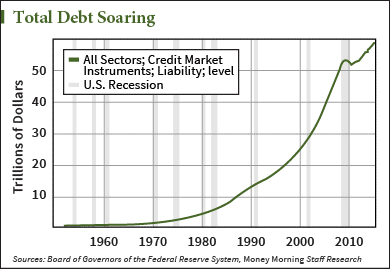 For one thing, Americans have rung up a massive amount of debt. In 10 years, from 1992 to 2002, total debt doubled from $15 trillion to $30 trillion. Now, it's nearly doubled again. As of the fourth quarter of 2014, total debt Americans owed was $58.7 trillion.
For one thing, Americans have rung up a massive amount of debt. In 10 years, from 1992 to 2002, total debt doubled from $15 trillion to $30 trillion. Now, it's nearly doubled again. As of the fourth quarter of 2014, total debt Americans owed was $58.7 trillion.
Contributing factors include soaring student loan debt, a hangover from the housing bubble, and Americans' long love affair with credit cards.
Decades of borrowing, however, has just about reached its limits. But if Americans aren't going to spend as much borrowed money, consumer spending - which drives 70% of the U.S. economy - will take a big hit.
And any slowdown in consumer spending will eat into corporate profits, which will hurt stock prices.
U.S. Stock Market Crash 2015, Chart No. 3: Americans Are Spending Less
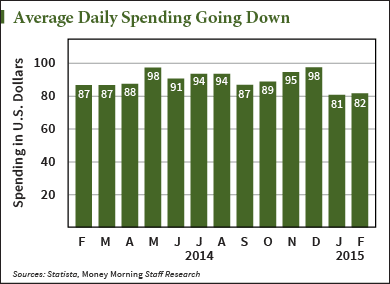 The slowdown may have already started. According to Statista, the average amount of money Americans are spending has dropped off in recent months.
The slowdown may have already started. According to Statista, the average amount of money Americans are spending has dropped off in recent months.
Through most of 2014, Americans said they spent between $87 and $98 a day. But in January the number fell to $81, recovering only slightly to $82 in February.
That's about a 10% decline from where spending was through most of last year - more than enough to have a negative impact on earnings, which have enough headwinds already with the strong U.S. dollar.
U.S. Stock Market Crash 2015, Chart No. 4: Average Income Has Fallen
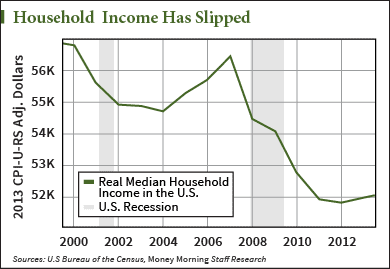 Besides mounting debt that needs to be paid back at some point, Americans just aren't making as much money as they were a few years ago.
Besides mounting debt that needs to be paid back at some point, Americans just aren't making as much money as they were a few years ago.
Real median household income in the U.S. peaked at $56,895 in 1999, then dipped to $54,664 in 2004 in the wake of the dot-com bust.
But since hitting $56,436 in 2007, the year before the financial crisis, median household income slumped to as low as $51,758 in 2012. From the all-time peak in 1999, household incomes have declined about 9%.
And many Americans are struggling on incomes that make it tough to maintain a middle class lifestyle. Nearly two-thirds, 63%, of American workers make less than $40,000 a year. And more than half, 52%, make less than $30,000.
The American consumer - the engine of the U.S. economy - is sputtering.
U.S. Stock Market Crash 2015, Chart No. 5: Everything Costs More
 Government officials, as well as the U.S. Federal Reserve, don't think inflation is high enough. They say it's needed to spur economic growth.
Government officials, as well as the U.S. Federal Reserve, don't think inflation is high enough. They say it's needed to spur economic growth.
But for rank-and-file Americans, inflation is a disaster. It slowly eats away at the value of money, destroying its buying power over time. A 1913 dollar, for example, has the buying power of $0.04 today.
But you don't need to wait 100 years to feel the pain of inflation. A dollar earned in 2000 only buys $0.73 worth of goods today.
Meanwhile, as we saw in the previous chart, median household income is down 9% over the same period. It doesn't take a rocket scientist to figure out why Americans can't buy as much as they used to.
U.S. Stock Market Crash 2015, Chart No. 6. Fewer Americans Are in the Workforce
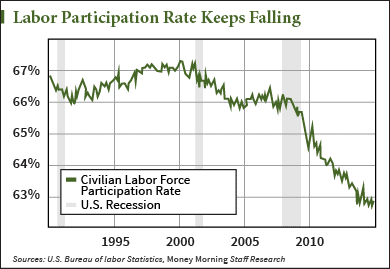 Another drag on consumer spending is the drop in the labor force participation rate. The percentage of U.S. adults in the workforce has dropped from about 67% to 63% over the past 15 years.
Another drag on consumer spending is the drop in the labor force participation rate. The percentage of U.S. adults in the workforce has dropped from about 67% to 63% over the past 15 years.
Part of the reason is that Baby Boomers are reaching retirement age. But part of it is a hangover from the recession. Some people lost their jobs and were never able to re-enter the workforce.
Regardless of the cause, fewer people earning paychecks means less money in the U.S. economy. That goes for retirees, too. While some new retirees may be well off, many scale back once they're on a fixed income.
And less overall spending leads to lower corporate profits.
U.S. Stock Market Crash 2015, Chart No. 7: Margin Debt Flashing a Warning
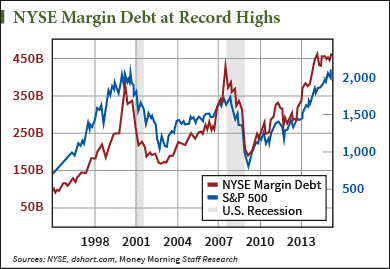 Regular Americans aren't the only ones with dangerously high levels of debt. Wall Street's high rollers have borrowed at record rates in their never-ending pursuit of fatter profits.
Regular Americans aren't the only ones with dangerously high levels of debt. Wall Street's high rollers have borrowed at record rates in their never-ending pursuit of fatter profits.
Margin debt accumulates when investors borrow money to buy stocks. Using margin accounts gives investors more buying power, but carries risk. If the stock goes up as hoped, the investor earns more profit. But if the stock goes down, the losses will be greater as well.
Margin debt on the New York Stock Exchange has been near record levels - around $450 billion - for more than a year. That tells us there's a lot of risk built into the recent market highs.
But it's also a red flag for a U.S. stock market crash. The last two times margin debt peaked, a stock market crash followed.
Who to Blame for 2008: The 2008-2009 U.S. stock market crash was the worst since the Wall Street Crash of 1929. The Dow Jones Industrial Average plunged 54% in 17 months. Many Americans suffered heavy losses in the stock market. Millions lost their jobs. And these 10 people are the most responsible for causing the crisis...
About the Author
David Zeiler, Associate Editor for Money Morning at Money Map Press, has been a journalist for more than 35 years, including 18 spent at The Baltimore Sun. He has worked as a writer, editor, and page designer at different times in his career. He's interviewed a number of well-known personalities - ranging from punk rock icon Joey Ramone to Apple Inc. co-founder Steve Wozniak.
Over the course of his journalistic career, Dave has covered many diverse subjects. Since arriving at Money Morning in 2011, he has focused primarily on technology. He's an expert on both Apple and cryptocurrencies. He started writing about Apple for The Sun in the mid-1990s, and had an Apple blog on The Sun's web site from 2007-2009. Dave's been writing about Bitcoin since 2011 - long before most people had even heard of it. He even mined it for a short time.
Dave has a BA in English and Mass Communications from Loyola University Maryland.



